10 Tips & Checklists for Cleaning and Sanitizing School Backpacks, Lunchboxes, and More!
As a parent, I know exactly what it’s like to send your little ones off to school squeaky clean only to have them walk back in the door covered from head to toe in dirt and germs.
In this article, we’ll share 10 essential tips that every parent should know to help keep their child’s school backpack, lunchbox, electronics, water bottle, and other stuff clean and germ-free.
We’ll discuss various strategies, such as regularly cleaning and sanitizing their belongings, proper food storage, and creative ways to encourage good hygiene habits even when they’re away from home.
With these tips, you can feel more confident about your child’s well-being at school and give yourself some peace of mind. So let’s dive in and start de-germing their school gear and lunchbox for a healthier school experience!
Learn the High-Touch Zones on School Stuff
As a parent, keeping your child’s belongings germ-free is crucial for maintaining their health, and that becomes even more relevant when it comes to school gear and lunch boxes.
Here are some tips to help you identify and de-germ the high-touch zones on school items:
- Backpacks: Your child’s backpack is constantly being handled, and it picks up germs from various surfaces. Pay special attention to zippers, handles, and straps. Regularly use disinfecting wipes or a clean cloth with mild soap and water to clean these areas.
- Lunchboxes: Lunchboxes are in direct contact with your child’s food. Clean them daily, focusing on handles, zippers, and the interior lining. Use soap and water for the inside, and a sanitizing wipe for the exterior.
- Writing utensils: Pens and pencils are used frequently throughout the day. Encourage your child to keep their writing utensils in a designated case and remind them not to share them with others. Wipe down the case with a disinfectant wipe periodically.
- Notebooks and binders: When sanitizing notebooks and binders, pay attention to the covers, spine, and edges, as these are the areas that students frequently touch. Gently clean these surfaces using a disinfectant wipe, taking care not to damage the paper inside.
- Electronic devices: If your child uses a tablet or laptop at school, they should wipe down the screen, keyboard, and outer surfaces regularly with a tech-friendly disinfectant wipe.
- Reusable water bottles: Germs can accumulate on the lids and mouthpieces of reusable water bottles. Clean these areas daily using hot soapy water or a designated bottle brush.
- Desks and chairs: At home, sanitize the surfaces of your child’s desk and chair regularly with a disinfectant wipe or spray. Encourage your child to do the same at school when possible.
By focusing on these high-touch zones, you can minimize the transfer of germs and help keep your child healthy throughout the school year.

The Right Way To Clean Backpacks
Cleaning backpacks regularly not only helps maintain a good appearance but also keeps germs and bacteria at bay.
Follow these tips to clean your child’s backpack effectively:
- Empty the backpack: Before you start cleaning, make sure to empty all the pockets and compartments. Shake it upside down to remove any debris, crumbs, or loose items.
- Spot cleaning: For small stains, use a mixture of baking soda and dish soap. Create a paste by combining 3 tablespoons of baking soda with about 1 tablespoon warm water. Apply the paste on the stained area using a toothbrush or a soft cloth, and gently rub the fabric in a circular motion. Once the stain has been lifted, rinse the area with a damp cloth.
- Hand washing: If your backpack is not machine washable or has a delicate material, you can hand wash it. Fill a sink or a large container with warm water and add a few drops of mild detergent. Soak the backpack for about half an hour, ensuring that it is fully submerged. Gently scrub the exterior and interior using a soft sponge or brush. Rinse thoroughly with clean water until all soap residue is removed.
- Machine washing: If the backpack is machine washable, use a gentle cycle with cold water and mild detergent. Put the backpack in a laundry bag or pillowcase to protect it from potential damage. Make sure to check the manufacturer’s instructions for any specific care information.
- Drying: Never use a dryer for your backpack, as it can damage the fabric or zippers. Instead, hang it up to air dry, preferably outdoors, to avoid any lingering dampness. Ensure that all compartments and pockets are left open to promote airflow.
- Storage: Store the backpack in a clean, dry place when not in use. Keep it away from direct sunlight and excessive moisture to maintain its appearance and longevity.
By incorporating these tips into your cleaning routine, you can ensure your child’s backpack stays looking great and germ-free throughout the school year.
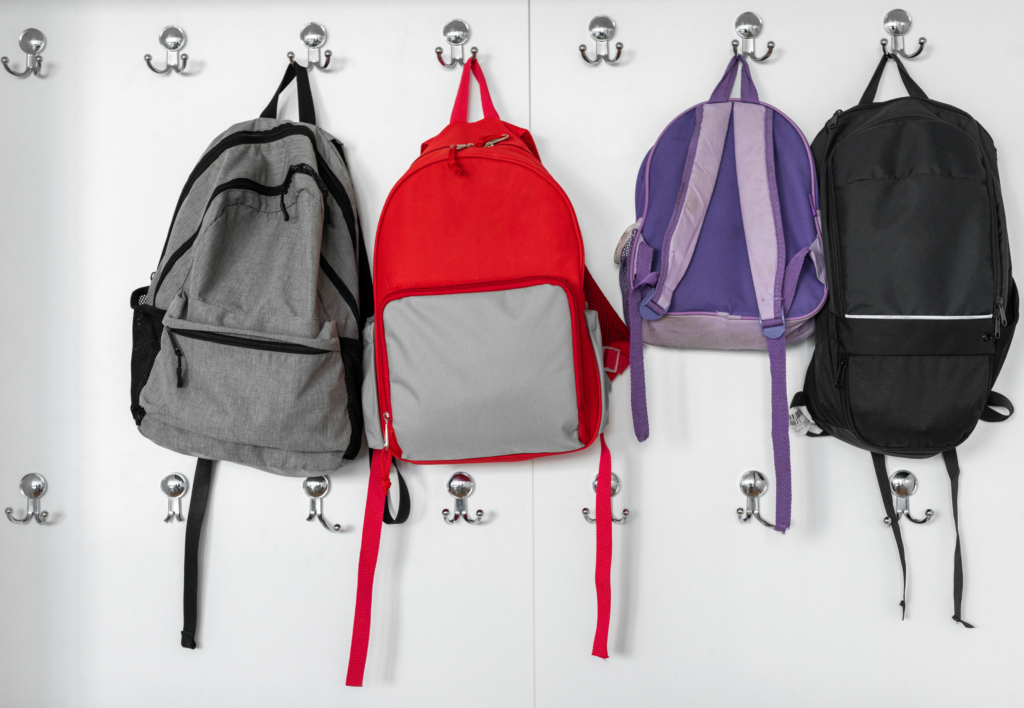
Daily Lunchbox Sanitizing Routine
Maintaining a consistent and effective daily lunchbox sanitizing routine is essential for keeping your child’s packed lunch safe and healthy.
Here are some helpful steps to follow:
- Empty and inspect the lunchbox: Start by emptying the lunchbox, including any leftover food, wrappers, or containers. Check for crumbs, spills, and stains that need attention.
- Wipe down all surfaces: Use a clean cloth or sponge dampened with warm soapy water to wipe down the lunchbox’s interior and exterior surfaces. Focus on any visible stains or residues. For tight spaces or stubborn spots, a toothbrush may be useful.
- Clean containers and utensils: Wash all containers, such as thermoses and bento boxes, as well as utensils, either by hand with warm soapy water or in the dishwasher, depending on the manufacturer’s recommendations.
- Rinse and air-dry: Rinse the lunchbox with clean water to remove any soap residue and allow it to air dry, preferably overnight or in a well-ventilated area.
- Utilize the freezer: If your child’s lunchbox has an unpleasant odor, try placing it in the freezer overnight. The cold temperatures can help eliminate strong smells.
- Focus on food safety: In addition to the lunchbox itself, pay attention to the safety of the food you’re packing for your child. Keep hot foods hot and cold foods cold, using insulated containers and ice packs as needed.
- Rotate lunch items: To prevent boredom and improve food safety, regularly rotate the menu items in your child’s packed lunch. Offer a variety of fruits, vegetables, whole grains, and proteins to create a balanced meal.
- Pack smart: Utilize portion control, reusable containers, and smart packing techniques, like separating wet and dry ingredients, to keep the lunchbox clean and minimize waste.
- Address food allergies: Be mindful of any potential allergens in your child’s lunch, as well as any school guidelines regarding allergens in packed lunches.
- Seek feedback: Encourage your child to provide feedback on what they enjoyed or didn’t like. The more involved they are in the process, the more likely they are to eat their lunch and maintain a clean lunchbox.
By following this daily sanitizing routine, you will greatly reduce the risk of germs and bacteria in your child’s lunchbox, contributing to a healthier and more enjoyable lunchtime experience.
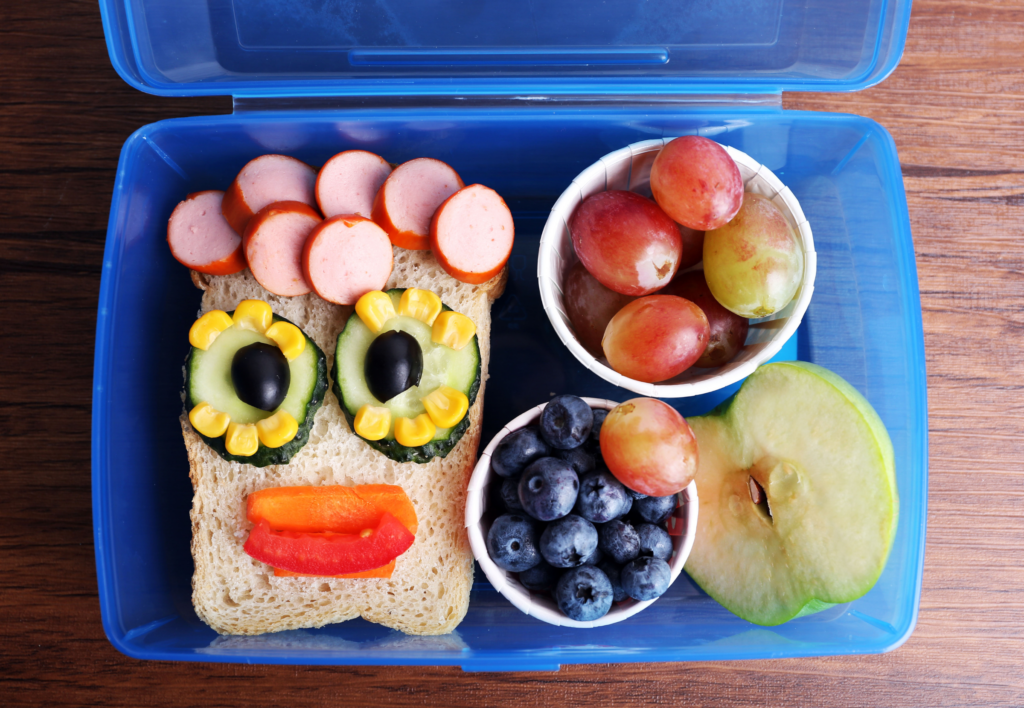
Keeping Backpacks and Lunchboxes Smelling Good
Maintaining a clean and fresh-smelling backpack and lunchbox is essential for your child’s safety and overall well-being.
Here are some helpful tips for keeping their school gear in top shape:
- Cleaning regularly: Routinely clean both the backpack and lunchbox, ideally once a week, to prevent any lingering odors or bacteria. Wipe down the interior of the lunchbox using a cloth dampened with scented vinegar, which is known for its powerful properties that fight stains, buildup, odors, and germs without leaving a strong smell.
- Using baking soda: Baking soda can be another helpful tool in deodorizing your child’s lunchbox or cooler bags. Sprinkle some on a damp cloth and wipe inside, or pour a small amount in the lunchbox, let it sit for a few hours, and then rinse thoroughly. Baking soda is a natural mild abrasive that helps lift surface stains without using harsh chemicals.
- Spot cleaning: When dealing with stubborn stains on the backpack or lunchbox, spot clean using a mixture of warm water and a small amount of gentle liquid detergent or dish soap. Apply the solution with a soft-bristled brush and scrub gently to remove the dirt, then rinse clean.
- Air drying: After cleaning your child’s backpack and lunchbox, make sure to air dry them completely before storing or using them again. This will help avoid any potential mold or mildew problems that could result from dampness.
- Investing in quality materials: Choose school gear made from high-quality, easy-to-clean materials, such as washable fabrics, plastic, or stainless steel containers that are both durable and more resistant to odors and stains.
By following these simple tips and incorporating them into your weekly routine, you’ll ensure your child’s backpack and lunchbox stay clean, safe, and free of unpleasant odors.
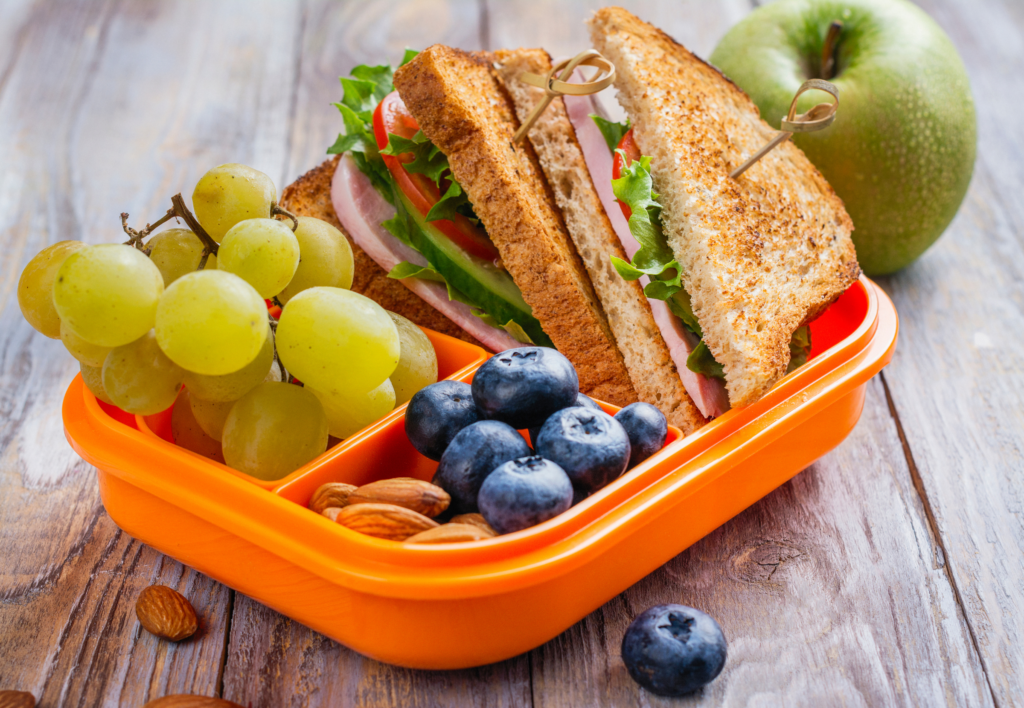
How To Clean and Sanitize School Shoes
When it comes to maintaining your child’s school shoes, cleanliness and hygiene are crucial. Here are some helpful tips to ensure their shoes stay in top shape and germ-free.
Here is the right way to tackle it:
- Remove Visible Dirt and Grime: For leather or synthetic shoes: Use a soft cloth or brush to clean off any visible dirt. For suede shoes: Avoid using water. Instead, gently brush away excess dirt with a soft bristle brush.
- Prepare a Cleansing Solution: Mix warm water, mild detergent, and a teaspoon of baking soda in a bowl. This homemade solution can also be used on backpacks.
- Sanitize the Shoes: Apply the solution using a clean cloth or toothbrush. Scrub gently to remove any remaining dirt and kill germs.
- Address Shoe Odors: Sprinkle some baking soda inside each shoe. Let it sit overnight and shake out the excess the next day to remove odors and bacteria.
- Air-Dry the Shoes: After cleaning and sanitizing, let the shoes air-dry completely. Avoid direct sunlight or artificial heat to preserve their shape and material quality.
Keeping your child’s school shoes clean and germ-free will not only maintain their appearance but also contribute to a healthier home environment.
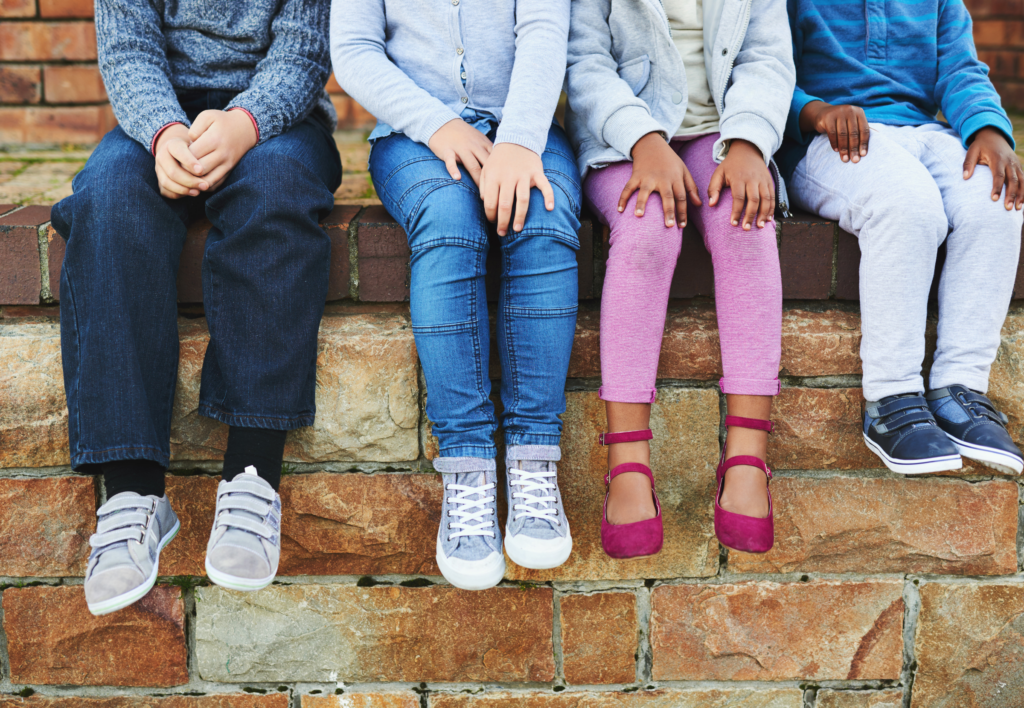
How To Maintain a Germ-Free Water Bottle (You Have To Clean It!)
Maintaining a germ-free water bottle is essential to ensure your child’s health and prevent the growth of bacteria and mold.
Here are some tips to keep your child’s water bottle clean and germ-free:
- Clean it daily: Make it a habit to clean your child’s water bottle every day. Wash it with warm, soapy water and rinse thoroughly. Be sure to remove all traces of soap before reusing the bottle. If possible, invest in multiple water bottles so you can rotate them, allowing for thorough drying between uses.
- Use a bottle brush: A bottle brush with a long handle and bristles can help reach into the corners and crevices of the water bottle, making it easier to clean. This can be especially beneficial for bottles with narrow necks.
- Disinfect with vinegar: Vinegar is an excellent natural cleaning agent with antimicrobial properties. Fill the water bottle with a 1:1 mixture of white vinegar and water, then let it soak for a few hours, or even overnight. Rinse thoroughly afterwards.
- Don’t forget the cap and straw: The cap and straw of the water bottle can be a breeding ground for bacteria. Be sure to disassemble and clean all parts of the bottle, including the cap, straw, and any seals or gaskets.
- Air it out: After cleaning, let the water bottle air dry completely in a well-ventilated area. Keeping the bottle open when not in use will also help prevent the growth of mold and bacteria.
- Keep it simple: Avoid putting anything other than water in the bottle, such as juices or sports drinks, as they can create a more favorable environment for bacteria to grow. If you must use the bottle for these liquids, be sure to clean it thoroughly afterwards.
- Go BPA-free: When choosing a water bottle for your child, consider a BPA-free option. BPA is an industrial chemical that has been linked to health concerns, and it can leach into your child’s water if the bottle is not properly maintained.
By following these tips, you can help ensure that your child’s water bottle stays clean and germ-free, contributing to their overall health and well-being.

How To Sanitize or De-Germ School Electronics
In today’s world, keeping your child’s school electronics clean and germ-free is more important than ever.
Here are some friendly tips to help you sanitize or de-germ their tech at home:
- Unplug and power down: Before cleaning any electronic devices, make sure they are turned off and unplugged. Remove batteries from wireless keyboards and disconnect any external devices. This will prevent any electrical accidents and ensure proper cleaning.
- Isopropyl alcohol solution: Create a mixture of 70% isopropyl alcohol and 30% water, which is a safe and effective solution for sanitizing electronics. You can use alcohol wipes as well. Apple recommends using 70 percent isopropyl alcohol wipes for their products, but make sure to check specific cleaning instructions for the device’s brand.
- Use a microfiber cloth: Gently wipe down the surfaces of the electronic devices with a disposable microfiber cloth. The cloth should be dampened with the alcohol solution, but not dripping. This ensures thorough cleaning without the risk of damaging the electronics.
- Don’t forget nooks and crannies: Make sure to clean hard-to-reach areas like seams and corners, as well as any ports or buttons, since germs can also accumulate in these spaces.
- Ensure proper drying: After cleaning, allow the devices to fully air-dry before turning them back on. It’s crucial to avoid powering them on while they are still damp, as this might cause damage.
- Establish a routine: Make it a habit to clean the devices regularly, especially during flu season or when there’s an ongoing outbreak. It’s a good idea to put a weekly or monthly reminder on your calendar to help you stay on top of this task.
- Educate your child: Teach your children the importance of sanitizing their devices and offer them guidance on how to do it safely. By instilling good habits early, they’ll be better equipped to keep their tech germ-free.
- Organize a clean storage space: Designate a clean storage space for electronics in your home, preferably in the bedroom. Make sure the area is free from dust and moisture to help maintain the cleanliness of the devices.
- Consider protective covers: Invest in protective covers or cases for devices, which can be easily wiped down and provide an extra barrier against germs.
- Incorporate school administration: Share these tips with your child’s school, encouraging them to maintain regular cleaning and sanitizing practices for shared electronics like computer labs and tablet carts.
By following these tips, you’ll help ensure that your child’s school electronics remain clean and germ-free, making for a safer and healthier learning environment.
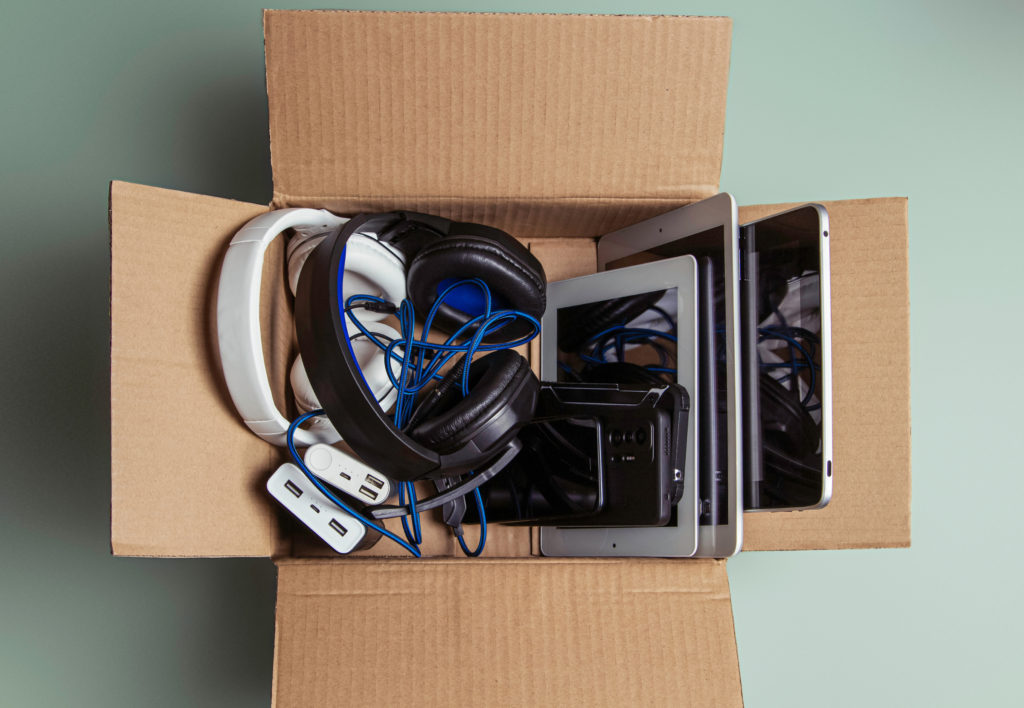
How To Sanitize Other School Supplies (Binders, Pens, Etc)
As a parent, keeping your kids’ school supplies clean is essential for maintaining a healthy learning environment at home. Here are some tips to help you sanitize various school items effectively:
- Binders: Use a damp cloth with a mild soap solution to clean the inside and outside surfaces of the binder. Ensure it dries completely before storing it away.
- Pens and Pencils: For plastic and metal pens, use a diluted alcohol solution (at least 60% alcohol) on a soft cloth or paper towel to wipe down the surfaces. For wooden pencils, use a mild soap solution and a damp cloth to gently clean them.
- Rulers and Protractors: Clean these using a damp cloth with soapy water. Rinse them under running water and dry them thoroughly before storing them.
- Scissors and other sharp objects: Handle these carefully. Use a cotton ball dipped in rubbing alcohol to disinfect the blades and handles, and ensure they are completely dry before storing them safely out of children’s reach.
- Textbooks and Workbooks: While it is not feasible to sanitize every page, you can use cleaning wipes or a damp cloth with mild soap to clean the hardcovers and outer edges of the books.
- Electronics (laptops, tablets, etc.): Follow the manufacturer’s guidelines for cleaning electronic devices. Generally, a soft cloth dampened with a diluted alcohol solution or specialized cleaning wipes are recommended for screens and outer surfaces of electronic devices.
- Storage solutions: Regularly clean and sanitize desks, shelves, and other storage spaces that make contact with school supplies. A mixture of equal parts water and white vinegar makes for an excellent cleaning solution.
- Art supplies: Wash paintbrushes, crayons, and other art materials with soapy water, and let them dry completely before storing them.
- Backpacks: Empty out the contents, and clean the inside and outside surfaces using a damp cloth with a mild soap solution. Allow the backpack to air dry before using it again.
- Lunchboxes: The best method to clean lunchboxes is handwashing them with warm, soapy water. Use a scrub brush for hard-to-reach areas, and allow them to air dry before using them again.
By following these cleaning tips, you can ensure your children’s school supplies are germ-free and promote a healthy learning environment within your home.
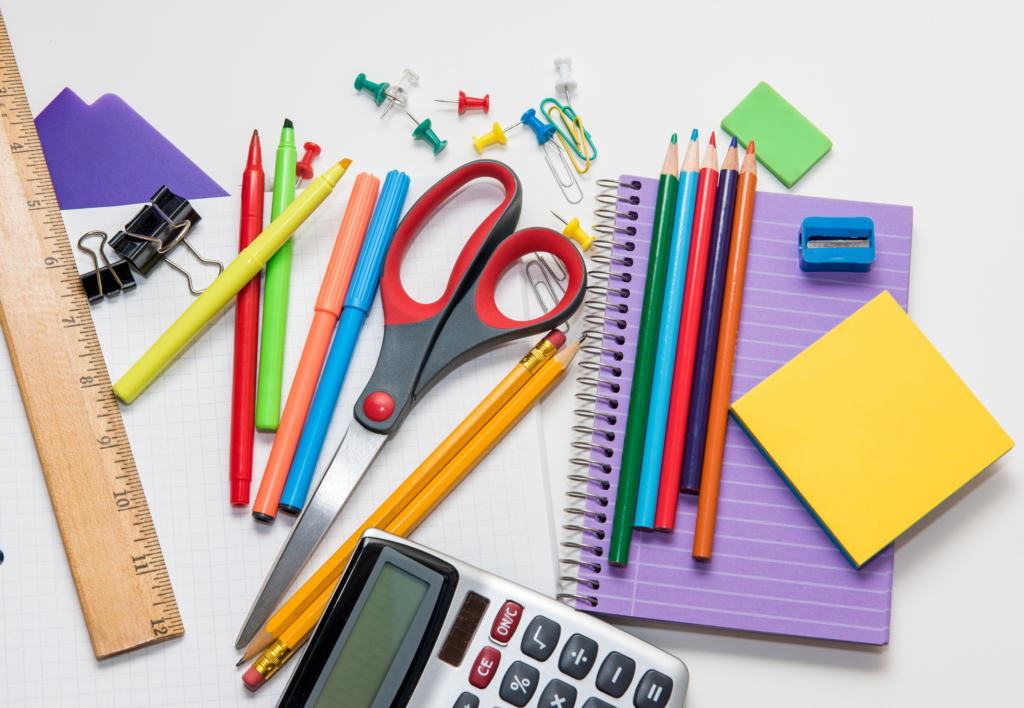
Training Your Kids With Proper Hygiene Habits
As parents, teaching your kids proper hygiene habits is essential in maintaining their health and preventing the spread of germs. To help you with this, here are a few friendly tips that every parent should know:
- Handwashing: Encourage your kids to wash their hands frequently, especially before and after meals, after using the restroom, and after playing at school or home. Make sure they use soap and water, and teach them to lather for at least 15 seconds, which is about as long as it takes to sing “Happy Birthday” twice.
- Nail care: Teach your children to keep their nails clean and trimmed. Dirty and long nails can harbor bacteria, leading to infections. So, regularly help them with nail care and make it a fun and engaging activity.
- Coughing and sneezing etiquette: Remind your kids to cover their nose and mouth when they cough or sneeze, preventing airborne germs from spreading. Encourage them to use a handkerchief or the crook of their elbow instead of their hands to avoid contaminating surfaces.
- Personal items: Teach your children not to share personal items such as water bottles, lunchboxes, towels, or brushes with their classmates or friends to reduce germ transmission.
- Bathing and oral hygiene: Establish a regular bathing routine and stress the importance of proper oral hygiene. Make sure they clean their teeth at least twice a day and, if needed, engage them in fun activities to make brushing more enjoyable.
Implementing these hygiene habits will contribute to your child’s overall health, giving them a better learning experience at school, and making parenting an even more rewarding experience for you.
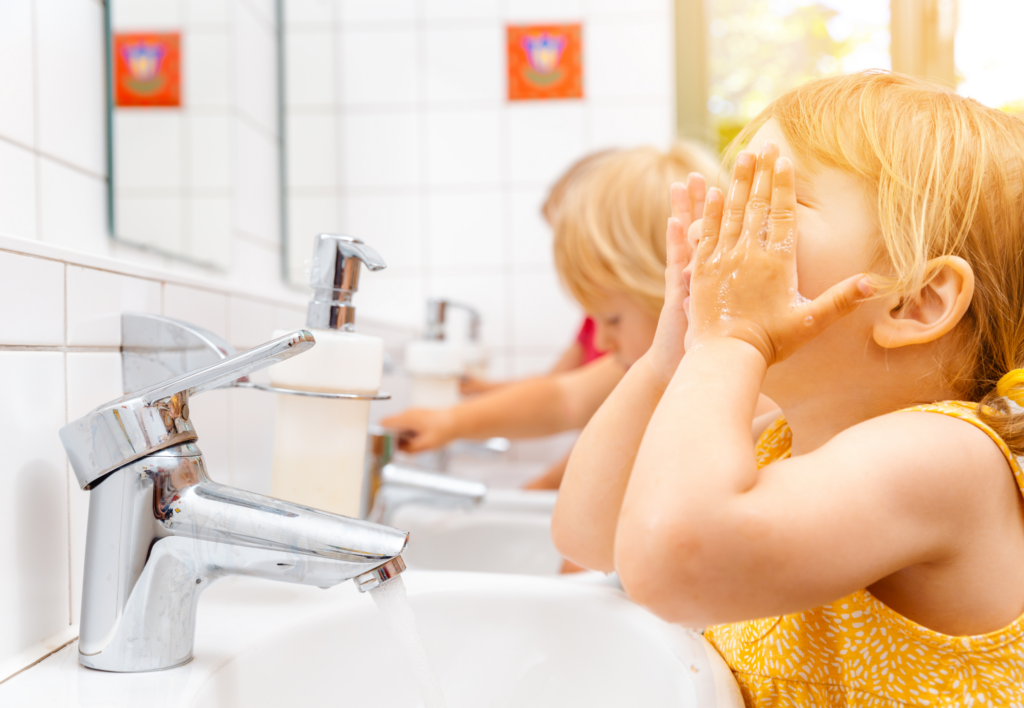
Storing School Stuff After School
As a parent, it’s important to keep your child’s school gear and lunchbox clean and organized for their health and well-being. Here are a few tips on how to store school stuff after school:
- Create a designated area for school gear: Pick a specific spot in your home where all school items will be placed, such as in a bedroom or entryway. This helps to keep things organized and prevents clutter.
- Use hooks and hangers for backpacks and outerwear: Install hooks or hangers in the designated area for easy storage of backpacks, jackets, and hats. It’s also a good idea to add a shelf or cubby for shoes and other small items.
- Clean lunchboxes daily: Empty your child’s lunchbox as soon as they get home from school, and clean it thoroughly. This prevents the growth of bacteria and ensures a healthier lunch experience the next day.
- Store lunchboxes in a well-ventilated area: Once cleaned, let the lunchbox air dry in an open space. This helps to prevent the growth of mold or bad smells.
- Make a schedule for washing school gear: Wash school bags, jackets, hats, and other items on a regular basis. This helps to maintain their cleanliness and prevents the spread of germs.
- Ensure proper ventilation in storage areas: Make sure that your designated storage areas are well-ventilated to avoid dampness and prevent mold growth.
- Teach your child good habits: Encourage your child to put their school items away as soon as they get home, and to help with the cleaning process when needed. This helps them develop good habits and learn the importance of staying organized and maintaining a clean environment.
Remember, maintaining a clean and organized space for your child’s school gear can contribute to their overall health and well-being. Follow these simple tips to make after-school storage a breeze.
Let Us Know How We’re Doing!
Did this expertly prepared resource answer your question?
Do you have another question about home maintenance, home improvement projects, home appliance repair, or something else?
Get more information, send in questions and keep the discussion going by contacting the I’ll Just Fix It Myself company customer service team at at 1-800-928-1490 or Email us at [email protected]
